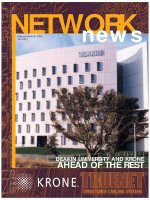Tài liệu ADC KRONE Network News - Vol.12 No.1 - 2005 pptx
Bạn đang xem bản rút gọn của tài liệu. Xem và tải ngay bản đầy đủ của tài liệu tại đây (842.64 KB, 16 trang )
In this issue:
■
Successful PoE Deployments
■
Another Coup for CopperTen
™
■
PBE Perfection
■
High Speed Needs for Broadband 25
Vol 12 No1 2005
ONE COMPANY Endless Solutions
I
t’s hard to believe that we’ve already come full
circle to the start of another New Year, so many
changes and achievements have marked the past
12 months.
In a year dominated by the ADC acquisition of
KRONE, 2004 also saw the launch of KRONE’s
CopperTen
™
technology, the world’s first 10
gigabit UTP copper structured cabling system
covering the full 100 metre range - a year ahead
of our competitors.
In May, our ongoing commitment to
manufacturing excellence was recognised with a
swag of awards from the Central Coast
Manufacturers’ Association including the
prestigious Manufacturer of the Year award.
Other highlights include an AEEMA High
Commendation for Environmental Excellence,
Finalist in the Telstra Vendor of the Year awards
and the launch of our online training service for
installers.
The New Year also marks the start of a new era,
and you will see a transformation, with the ADC
name tied to KRONE branded products, as we
begin to offer a combined range of products and
services to the marketplace.
We are proud of the contribution that our
quality products, produced here at the Berkeley
Vale manufacturing facility, are now making as
part of the larger ADC KRONE portfolio.
As a united company we have strengthen our
capabilities. Resulting in a new entity that makes
ADC KRONE one of the most significant
infrastructure companies in the data
telecommunications market. This means that we
can better serve the needs of our customers with
greater range, reach and capacity.
We look forward to seeing you at our national
roadshow in April, where we will showcase the
combined company and portfolio to the
marketplace, for further details please see the
back page of this issue.
Thank you for your continued commitment and
support throughout 2004, we wish you all the
very best for a successful year ahead.
Bob Fitzgerald
VP Regional Director,
Indo-Pacific Region
2
❙
NETWORKnews
GREATER RANGE, REACH
AND CAPACITY!
Technical Articles
7 Patch By Exception Installations
Customer Stories
5 Syncroness Chooses
Revolutionary CopperTen
8 PBE Proves Perfect For Innovative
Call Centre
12 Infrastructure Improves Data
Centre Reliability
14 Broadband 25 Supports Telco’s
High Speed Plans
News
3 Promotions And New Employees
4 ADC KRONE: One Company.
Endless Solutions
16 Club KRONE Update
16 Roadshow 2005
Business Articles
10 The Five Keys To Successful PoE
Deployments
Editor: Joanna Parsons
Art Direction: Nora Collins
Website: adckrone.com.au
CONTENTS
Copyright © 2001 KRONE Australia Holdings Pty. Limited
T
he last three months have been very exciting
for the ADC KRONE sales division with new
positions being created and new staff coming on
board, as well as promotions within the team to
strengthen our position for the coming financial
year.
Firstly, Ian McCully, whilst
still continuing to perform his
duties as State Manager for
Queensland, has taken on an
additional role, at a national
level, as Distribution Manager
taking over from myself the
day to day activities with our
distribution partners.
Ian’s long-term service to KRONE and his
extensive distribution experience will be an
enhancement to achieving greater success with
our distribution partners in 2005.
Secondly, Murray Dickson,
formerly a Sales Engineer
with the Victorian Sales
Office, has been promoted to
the position of Vic/Tas State
Manager. Murray has been
with the organisation since
August
2001 and
has been a key player in the
success of the Victorian Office
to date.
Also, Adrian (Ade) Croucher,
a relatively new addition to
our NSW Office. Ade has
been appointed to the
position of NSW Sales Engineer and brings to the
organisation a wealth of experience and technical
knowledge in the data communications field. Ade
is also a CCNA (Certified CISCO Network
Administrator).
The latest addition to our
sales team is Sandro Beltrami
who commenced employment
with us on the 15 November
as Victorian Sales Executive.
Sandro has had many years
experience in this industry
and will bring to the
organisation further
knowledge and skills to assist in our success over
the coming years.
Finally, a mention to Carl
Holmes, our Western Australian
Sales Executive, who recently
won the Hagemeyer
Suppliers Rep of the Quarter
Award. This is a first for ADC
KRONE and is indicative of
our ongoing commitment to
the Western Australian
marketplace. Congratulations Carl.
The last 12 months was one of the most
competitive and price eroding times and ADC
KRONE, has remained strong through this time
and increased our market share over our
competition.
We are also expecting some significant wins in
the carrier market over the coming 12 months.
We’re looking forward to another successful
year together in 2005.
■
NETWORKnews
❙
3
PROMOTIONS AND
NEW EMPLOYEES
Trevor Kleinert,
RCDD/NTS Specialist,
National Sales Director
ROADSHOW 2005
SEE BACK PAGE FOR DETAILS
S
ince the purchase of KRONE has been
announced we have been asked questions like
these “ how will ADC and KRONE be combined
as new entity?” “ how will the KRONE brand be
retained in the new go-to-market approach?”
and “ what will be the logo that will tie the
combination together?”
In this edition of Network News I would like to
share our new go to market approach for
Australia as well as globally.
THE RESEARCH
Knowing that the KRONE brand was one of KRONE’s
most valuable assets, ADC employed one of the
most prestigious brand strategy agencies globally –
FutureBrand, to develop the guidelines for the “new
ADC” brand architecture and to identify the most
benefitial use of the KRONE brand.
In a truly global effort, Futurebrand - together
with a joint ADC and KRONE team from around
the globe – questioned existing and potential
customers, partners and ADC and KRONE
employees from all over the world through:
■
Customer interviews
■
Customer and prospects e-survey
■
Selected employee and senior
management interviews
■
Employee e-survey
THE FINDINGS
The Research revealed that in the markets we
serve KRONE was the most valuable brand
globally, whereas ADC ranked fourth.
As expected, most of the strength of the ADC
brand stems from the Americas, whereas KRONE
has a clear brand leadership position in Europe,
Asia and Indo Pacific.
Not surprisingly the most important purchasing
drivers identified where – in that order:
■
Quality of products
■
Service & Support and
■
Ease of Installation
Interestingly this matched well with the
perceived strengths of both brands. ADC is most
strongly associated with high quality while KRONE
is strongly associated with both outstanding
service and support and high quality products.
This puts us into a very strong position
THE NEW LOOK AND FEEL
The new brand architecture will facilitate ADC’s
strategy to become a global leader in network
infrastructure, establishing the company as the
brand leader in the markets the company
serves, enabling ADC to operate as one
company, while leveraging the equity of the
KRONE brand.
In the Americas the combined entity will go to
market as ADC, as the research has clearly shown
that it is one of the strongest brands in that
market. However, the KRONE brand will continue
to be strongly associated with the legacy KRONE
products (For example KRONE modules will
always remain KRONE modules).
Outside of the Americas - in IndoPacific, Europe
and Asia – we will go to market as with a
combined ADC KRONE brand leveraging the
brand strength of the KRONE.
GO AUSSIE GO!
For Australia, the migration to ADC KRONE has
already started. You will see the ADC Logo
becoming part of our building signage at our
head office in Berkeley Vale and the sales offices
across Australia.
The changes we are planning will not impact the
way we do business and your complete
satisfaction will remain our priority. Our customers
can look forward to an enhanced portfolio that
combines the complete range of ADC KRONE
products
■
4
❙
NETWORKnews
ADC KRONE: ONE COMPANY.
ENDLESS SOLUTIONS
Moving forward as a combined entity .
Carsten Quiram,
Marketing Director,
Indo Pacific Region
The research revealed
that KRONE was the most
valuable brand
in our market . . .
D
esigning leading-edge products with leading-
edge tools; there is hardly a more precise
statement to illustrate why Syncroness has
emerged as a global player in new product
development. It also explains why the firm chose
ADC to provide high-performance cabling
infrastructure for its new corporate headquarters
in Westminster, Colorado.
“Our business is totally dependant upon our
number one tool - computer power,” said Jörg
Lorsheider, Syncroness’ director of business
development and sales. “Our network has to be
operational at peak proficiency 100 percent of
the time and that means it needs to work quickly.
When we considered the available choices for
high-performance Ethernet cabling, we found
that ADC’s new CopperTen system has
capabilities far beyond anything else on the
market.”
Syncroness employs more than 30 mechanical
engineers who use the most advanced computer-
aided design (CAD) software to invent or improve
a wide variety of products; from golf clubs to
exercise machines, medical devices to products
used in space exploration. With offices in Irvine,
California and Kuala Lumpur, Malaysia,
Syncroness engineers create and share immense
amounts of data among themselves and their
clients around the world.
“We operate a variety of different CAD systems
that require us to transfer multi-megabit files all
over the place,” said Lorscheider. “In fact, we
generate 25 gigs of new or revised data each
week and, for a business of this size, that’s a lot
of data. That’s more than a lot of big companies
generate.”
Syncroness also utilise complex simulation
software to perform fluid dynamics computations
and structural and thermal analyses on products.
These processes rely on distributed computing to
combine the resources of several separate
processors while consuming large amounts of
bandwidth in order to solve problems. “We share
information over tens of thousands of miles -
between the United States and Malaysia. We
certainly don’t want to create a bottleneck here in
our own office.”
Syncroness evaluated optical fibre in its quest to
provide the “biggest pipe” for its network. 10-
gigabit Ethernet performance was mandatory, yet
the cost of fibre optics proved prohibitive. “With
fibre, the expense is in the electronics,” said
David Yanish, of ADC’s global product
management group. “It’s necessary to invest in
complex hardware that converts electrical data
into photons (light) in order to send the
information over fibre optic cable, then additional
hardware to reconvert that information back into
electrons at the other end. That makes fibre
about six times more expensive than unshielded
twisted pair (UTP) cable. So, with a 10-gigabit
NETWORKnews
❙
5
SYNCRONESS CHOOSES REVOLUTIONARY
COPPERTEN
TM
FOR NEW HEADQUARTERS
we found that ADC’s new
CopperTen system has
capabilities far beyond
anything else on the market.
Syncroness engineers
utilise advanced
computer-aided
design (CAD)
software.
standard on the horizon, we went to work
developing a completely new copper solution -
CopperTen.”
10 GIGABITS AND BEYOND
For years, the industry predicted a shift toward a
fibre-based cabling structure within buildings.
But, as the need for a 10G Base-T standard
emerged, ADC’s KRONE development team
invested in breakthrough design and
manufacturing technologies, creating CopperTen,
a complete end-to-end cabling system that
delivers a solution more cost effective and easier
to install than shielded and fibre optic cabling
systems. CopperTen is the industry’s first
augmented Category 6 UTP cabling system and it
is guaranteed to enable 10-gigabit transmission
to be implemented to the full 100 metres
required for structured cabling systems. “In fact,
we can guarantee 18 gigabits per second of
channel capacity, and right now, no one else can
do that,” said Yanish.
“Cat 6 was supposed to be the next solution.
While it did produce more bandwidth, or pipe
size, it couldn’t support 10-gig Ethernet.
CopperTen does; it provides a ten-fold increase in
the transmission of large amounts of data as
measured by Shannon’s Capacity*, while
extending bandwidth to enable a capacity greater
than 18 gigabits per second up to 625 MHz. And
CopperTen does all this while eliminating alien
crosstalk.”
Alien crosstalk is signal noise generated from
adjacent cables. It has plagued high-capacity
copper cable designs for years. ADC combats
alien crosstalk with its patent-pending oblique
elliptical star filler, which never allows bordering
conductors to touch or get too close to one
another. This design, combined with the
company’s unique cable manufacturing process,
oscillate the cable pairs off-centre, isolating each
connector from the other.
“These components and designs working in
unison result in remarkable advantages that put
CopperTen in a league by itself, representing the
next generation of cabling technology.”
AN INVESTMENT IN TODAY - AND
TOMORROW
CopperTen re-establishes copper as the better
priced solution for “future-proofing” Local Area
Networks for the next protocols. This first-of-a-
kind product allows a confident reach to the next
level of transmission performance.
“As standards are changing, we have to stay
current and competitive,” said Lorsheider. “We
have to be ready for the future by investing in the
best products for our infrastructure, such as
CopperTen. We get paid by the hour, and the
more work we can produce during that hour, the
more value our customers receive while we
remain competitive. We expect this network
system to last and are pleased we won’t have to
rewire in five years.”
SYNCHRONICITY
Like all business success stories, this one
celebrates relationships between partners who
recognise the important role each plays in
reaching their individual goals. When it was time
to name their corporation, the five owners of
Syncroness chose a name that promoted their
formula for successful relationships. Says
Lorsheider, “The name describes our ability to
“synchronise” our capabilities and talents with
the needs of our customers; to harmonise our
bases of knowledge. That is the relationship we
form with our customers and the kind of
relationship ADC has formed with us.”
■
*Shannon’s Capacity formula is: Q = B log2 (1+S) concerning a
communications channel: the formula that relates bandwidth in
Hertz, to information carrying capacity in bits per second. Where
Q is the information carrying capacity (ICC), B is the bandwidth
and S is the signal-to-noise ratio. This expression shows that the
ICC is proportional to the bandwidth, but is not identical to it.
6
❙
NETWORKnews
“We have to be ready for the future by
investing in the best products for our
infrastructure, such as CopperTen.
CopperTen Patch
Panel (US version)
P
atch By Exception (PBE) installations use
disconnection modules in wall-mount, rack-
mount, island-mount or cabinet-mount
configurations. In all newly installed PBE systems
there are no patch cords visible to the front. The
system is totally hard wired in the rear from
network switch to work area, providing a secure,
reliable, high performance infrastructure from
switch to work area.
PATCH CORD USAGE
To make changes to the initially jumpered
installations use the following method;
1.Plug the patch cord into the work area
module that feeds the new outlet location.
The act of plugging a patch cord into the
module opens the internal spring contacts.
This disconnects the existing circuit to only
that work area and enables it to receive a
signal from a new source location.
2.Plug the source end of the patch cord into the
module on the network switch field.
This opens the internal spring contacts
disconnecting that existing switch module circuit
and feeds the signal via the patch cord to the new
work area outlet.
The patch cord has therefore created a new
patched configuration by-passing the original
hard-wired configuration. The patch has become
an exception to the original, hence the name
“Patch-By-Exception”.
PATCH CORD REMOVAL
To revert back to the original jumpered
configurations use the following method;
1.Unplug the patch cord from the network
switch field.
Unplugging a patch cord allows the internal
spring contacts to close thereby feeding the
signal to the original jumpered work area
outlet.
2.Unplug the patch cord from the work area
field.
Unplugging a patch cord closes the internal
spring contacts thereby feeding the signal from
the original jumpered work area outlet.
This sequence ensures maximum safety for
both operators and the cabling system. After
removing the patch cords they can then be hung
in a storage area ready for next time.
This article is a follow up to the KRONE Fact
titled “The Patch By Exception Solution”. For a
free copy, call 1800 801 298 or visit
www.adckrone.com.au
■
NETWORKnews
❙
7
PATCH BY EXCEPTION
INSTALLATIONS
Patch Cord Usage
Peter Meijer, JP BE MSc,
RCDD, Technical Training
Manager and Industry
Liaison
A
ustralian founded and operated, Customcall
is one of the largest privately owned call
centre operators in the region servicing blue chip
companies in fields including financial services,
energy and telecommunications.
Established in 1996, Customcall’s fundamental
purpose was to fill a gap in the teleservice
marketplace by creating a results-focused direct
sales channel. Customcall has since provided the
means for companies to provide a more efficient
and cost-effective service to clients’ existing
customers, using market intelligence to cross-sell
relevant products and ultimately improve the
value of relationships.
This winning formula combined with
continuous investment in people and technology
has seen the business grow from humble roots to
an annual turnover of $24 million and over 450
staff. Hence, a recent decision by Customcall to
move to larger premises to accommodate their
expanding operations. The new premises, located
in Kent Street Sydney, comprise two floors with a
capacity for 585 seats.
On evaluation of their existing structured
cabling solution, Customcall decided a new
system would be required for their operations at
the new premises. After some preliminary
research, including a visit to the KRONE stand at
CeBIT. Customcall met with KRONE endorsed
installer Tom Hammerl from Structured
Communication Systems to discuss the options
for a new system.
Customcall’s main requirements were scalability
and flexibility. A contact centre of Customcall’s
size and reputation is heavily reliant on the
technology behind it. In 2003, the Customcall IT
division was awarded the Deloitte Technology
Fast 50 where they were described as
“Technology leaders sustaining innovation and
growth”.
Customcall employ the very latest in call centre
technology, including systems such as: Avaya
Definity PABX system, Genesys Predictive Diallers
and Witness (Eyretel) Voice Recording system.
However, it is the way that the technology is
integrated to facilitate client requirements that is
revolutionary, developed with client flexibility and
user functionality in mind.
To support these ongoing technology initiatives
and growth projections, it was decided that a
HighBand 25 Patch By Exception (PBE) model
would be the best solution.
“We were impressed by the uniform, clean,
uncluttered look of the HighBand 25, which
looked to be a great improvement on our existing
solution which had become a somewhat unruly
bird’s nest”, said Andrew So, System Admin for
Customcall.
The HighBand 25 is a comprehensive Category
6 communications solution for leading
corporations and businesses, wanting the most
advanced network performance.
The HighBand 25 module has disconnect
contacts, providing for ease of administration and
8
❙
NETWORKnews
PBE PROVES PERFECT FOR IN
Leading call centre, Customcall, relies on HighBand
®
25 Patch By
Exception to deliver high performance technology initiatives
Ade Croucher,
Sales Engineer
“ installing approximately 130,000
metres of cable and 21 verticals,
making it the largest HighBand 25
installation of its kind”
Patch By Exception. Invented by KRONE, PBE
remains the highest performing, most cost
effective solution on the market today.
Tom Hammerl and the team from Structured
Communications completed the installation for
Customcall, installing approximately 130,000
metres of cable and 21 verticals, making it the
largest HighBand 25 installation of its kind in the
Southern Hemisphere.
The Customcall office environment has been
specifically designed to suit the needs of staff
working within a teleservice environment. In
keeping with the funky décor, Customcall utilised
umbilicals to house overhead cables from the
celing space. The umbilicals are a neat alternative
to static power poles and come in a variety of
colours and configurations, enhancing the overall
design and ambience of an office environment.
Upon completion of the project, Customcall
reported that the HighBand 25 installation had
been very smooth with no issues. Resulting in a
tidy, easy to maintain solution with a high-
performance Gigabit backbone.
“The PBE cabling has proven to be particularly
useful for our call centre environment”, said Mr
So.
■
NETWORKnews
❙
9
INNOVATIVE CALL CENTRE
INSTALLER SPOTLIGHT
Structured Communication Systems was established in 1994
with an aim to provide voice, data and electrical services as a
one-stop solution to the commercial and corporate sector.
Whilst relatively small, with a permanent crew of six staff,
Structured Communication Systems focus is to deliver first class
installations without compromise. Their niche, in this very
competitive industry, is ol d fashion service. With long standing
clients such as AAMI, P&O, Thiess and of course Customcall,
Structured Communication Systems’ goal is to build ongoing
partnerships with each of their clients.
Above and opposite page: Customcall’s wall of HighBand 25.
Left: Alex Price, ADC KRONE and Tom Hammerl, Structured Communications
Systems testing the installation.
G
iven the future impact PoE-based devices will
have on your business, it is important to
begin planning how to integrate PoE into your
current and future network. Per the IEEE standard
there are two methods to deploy PoE in your
network. Method 1 requires that Ethernet
switches inject power and data at the same time.
This may work well for new installations, where a
new switch must be purchased anyway. However
it will likely require a much larger power supply
and will be more expensive than a standard
Ethernet switch. These devices are referred to in
the 802.3af standard as “endspan” devices, since
the power is injected at the end of the structured
cabling where it terminates on the Ethernet
Switch. Method 2 involves using a dedicated
power injecting device in between the Ethernet
switch and the remote powered device. These
power-injecting devices are known in the
standard as “midspan” devices, and work well for
both new and existing installations with non-PoE
enabled Ethernet switches
When deployed correctly, Power over Ethernet
is safe, reliable, and cost effective. However
because Power over Ethernet is such a new
networking technology, it is important to
highlight five keys that will insure successful POE
deployments.
KEY #1: YOU MUST PROVIDE ENOUGH
POWER TO THE REMOTE POWERED
DEVICE
This first key does sound simple, however in
practice it is difficult. The IEEE 802.3af standard
identifies four possible power classifications. At
maximum, the powered remote device can draw
up to 12.95 Watts of power. Factoring loss
through the length of cable, this means that at
maximum, the power sourcing equipment must
have the ability to provide 15.4 Watts of power to
each port. In a 24-port Ethernet switch or
midspan device, this means that approximately
370 Watts (24 x 15.4 Watts) of power must be
available to supply the necessary power to each
port. For the Ethernet switches, additional power
above and beyond that required for Power over
Ethernet must be available for its switching
functions. With this in mind, pay very close
attention to the size of the power supply used in
each device. Midspan devices should have in
excess of 370 Watts available and Ethernet
switches should have significantly more
depending on how much power their switching
functions require. A rule of thumb here is to
check the power supply size used on a non-PoE
enabled switch and then add 15.4 Watts per port
to see if the power supply is large enough.
KEY #2: CONNECT THE POWER SOURCE
TO UNINTERRUPTIBLE AND REDUNDANT
POWER
The remote devices fed by Power over Ethernet
are typically mission critical devices. For instance,
an IP phone that loses power is a lost voice circuit.
Think about that for a moment. Regardless of
whether it is a traditional circuit switched analog
phone or an IP phone, it is a lifeline circuit. It has
to work. You must consider how you are going
to design your network to ensure that consistent
and reliable data transfer and power are
maintained to this critical device. Connect the
critical power sourcing devices to an
uninterruptible power supply (UPS), and use
devices with dual redundant power supplies to
ensure that your critical devices never lose
power.
KEY #3: DEPLOY ONLY IEEE 802.3AF-
COMPLIANT DEVICES
Prior to the June 2003 release of the IEEE 802.3af
standard, many companies chose to develop
products to various proprietary standards in order
10
❙
NETWORKnews
THE FIVE KEYS TO SUCCESSFUL POWER OV
Glen Johnston, Product
Manager, Structured
Cabling Products,
Indo Pacific Region
When deployed correctly,
Power over Ethernet
is safe, reliable,
and cost effective.
to provide power over Ethernet cabling. Many of
these devices are still being sold, even though the
standard is now released. Be sure to verify that
both the power sourcing device and the powered
remote device are compatible with each other. If
both devices list IEEE 802.3af in their
specifications, you are covered. But if any of the
devices you are using do not explicitly state
compliance to IEEE 802.3af, be cautious.
Carefully read the technical documentation and
contact the technical support number to
determine compatibility. Failure to do so will
leave you frustrated and will cost you time and
money.
KEY #4: PAY ATTENTION TO CABLING
PERFORMANCE SPECIFICATIONS
What category rating does your cabling
infrastructure have? Probably Category 5e or 6.
Now if you deploy Power over Ethernet with a
midspan device, how does that affect your
performance? Pay close attention to the
manufacturer’s specifications. Look for Category
5e and 6 compliance. Midspans should be treated
just like another patch panel in your channel; if
they are of a lower or unknown category than the
rest of your cabling, you may be significantly
degrading the performance of your
infrastructure. Also, remember that per the TIA
standards, only four connectors can exist
between the switch or hub and NIC. A midspan
device should be counted and treated as one of
these connection points. People commonly ask:
How far can I run Power over Ethernet. The
answer is 100 metres from switch or hub to NIC,
regardless of where the power is injected. The
limitation is not the power, it’s the Ethernet
cabling standards that limit the total length of
cabling to 100 metres.
KEY #5: UTILISE THE MOST COST
EFFECTIVE POE METHOD FOR YOUR
NETWORK
The business case behind deploying IP-based
technologies like WiFi and VoIP is to decrease
networking costs, not to increase them. Consider
this when deploying Power over Ethernet. A
significant benefit of PoE is that it runs on your
existing infrastructure. If you’ve recently
purchased or upgraded your Ethernet switches,
but they are not compliant to the IEEE 802.3af
standard, before you run out and buy all new
Ethernet switches (which you probably won’t do)
and before you abandon or delay your project
(which you don’t want to do), consider using
midspan devices to inject power. These devices
are very economical to purchase and install
relative to Ethernet switches, and they allow you
to insert standards-compliant Power over
Ethernet using your existing infrastructure,
including the existing Ethernet switch.
CONCLUSION
With adoption of the IEEE 802.3af standard,
Power-over-Ethernet is already accelerating
deployment of remote IP devices. As with all
standards, IEEE 802.3af effectively lowers the
cost for implementing projects using remote IP
devices because you have the option to power
devices such as VoIP phones and WiFi access
points without the expense of replacing
existing Ethernet switches. Still, whether
choosing a mid-span or end-span powering
solution, it is important to pay close attention
to the details outlined in this article to ensure
that you create a safe and reliable Power-over-
Ethernet solution.
■
Associate contribution by John Schmidt, Product Manager, ADC.
NETWORKnews
❙
11
OVER ETHERNET DEPLOYMENTS
consider using midspan
devices to inject power.
These devices are very
economical to purchase
and install
C
entrelink delivers a range of services to the
community, operating two main data centres
in Canberra. The company concluded that
maintenance of the current cabling infrastructure
supporting each data centre posed an ongoing
operational risk. To improve reliability and reduce
operating expenses, Centrelink committed to
upgrading the cabling system.
With the current cabling system, moves, adds,
and changes were time-consuming, disruptive,
and expensive. Cabling under raised flooring was
so poorly routed and managed that moving one
cable often disturbed 100 cables. The only viable
solution was to cut cables, drag them out, and
reinstall new cable -work that usually required
bids from cabling contractors due to the
unworkable tangle of copper and fibre cables
under the floor. As a result, routine
rearrangements or adding new servers was
difficult and time-consuming.
A focus of the project was to create a cabling
system that improved reliability, reduced costs,
and shortened intervals for moves, adds, and
changes.
SOLUTION
The new cabling system for the Centrelink data
centre pairs 10 high-density NGF (Next
Generation Frame) fibre distribution frames with
over 100 FL2000 fibre termination panels
mounted in frames and under raised flooring,
each FL2000 serving as an interconnect for servers
in the data centre.
In the past, adding a new server required one to
three weeks of work establishing long cable runs
(through an unmanageable cabling system) to
directly link equipment. Because the FL2000
panels and the NGFs were precabled to each
other during installation, new servers are now
brought on line in just hours by merely plugging
into the data centre network through the
FL2000s and moving or adding patch cords at the
NGF to complete the circuit. The FL2000
interconnect point saves time and labour during
moves, adds and changes.
Centrelink chose the NGF and FL2000 fibre
products to ensure greater reliability, protection,
and ease of use in the data centre. Distribution
frames were created by placing front facing NGFs
back-to-back. This novel application of ADC’s
popular fibre frame not only saved space but also
provided added capabilities for fibre
management. In this configuration, fibres could
be routed between NGFs without routing through
the channel normally set at the bottom of the
frame. For example, fibres could be run from the
third block of one NGF straight through to the
third block of the facing NGF. This unique
configuration not only protects fibres but also
provides fibre routing that is cleaner and easier to
perform.
In addition, Centrelink created a unique
application for FL2000 by installing some fibre
termination panels under raised flooring. Each
under-floor FL2000, which connects by IFC cable
to an NGF distribution frame, includes a special
enclosure that reduces dust and offers easy access
to pigtails. With FL2000 panels placed both under
the floor and in racks near server line-ups, adding
hard drives is as easy as adding a patch cord. With
the more efficient cabling scheme, equipment
changes-which happen often-are effected
without changing the infrastructure.
In reviewing vendors for the project, Centrelink
management established critical factors to rank
solutions from various vendors, as follows: cable
management, termination density, mounting of
frames, patch cord management, ease of use,
and labelling effectiveness. In all categories, ADC
equipment ranked either first or second. For
example, the NGF solution exceeded termination
density requirements by approximately 25%,
12
❙
NETWORKnews
INFRASTRUCTURE IMPROVES DATA CE
A focus of the project was to create a
cabling system that improved reliability,
reduced costs, and shortened intervals for
moves, adds, and changes.
Adelle Ward, Regional
Manager, Broadband
Infrastructure Access
allowing up to 3,974 terminations per square
meter. Even with the exceptional density, it was
apparent that the NGF design still provided
proper access to fibres for installation, patching,
and maintenance. In addition to the innovative
routing of cables between back-to-back front-
facing NGFs, ADC’s superior cable management
features included slack management and easy
access to terminations that enabled Centrelink to
settle upon only four patch cord lengths. Taken
together, ADC won the Centrelink business based
upon how fibres are routed and managed.
IMPLEMENTATION
During implementation, ADC was able to
provide off-the-shelf accessories and mounting
components for successful mounting of under-
floor FL2000s without delaying project
completion. In addition, the implementation team
was able to successfully work with limited access
times in the data centre and still meet deadlines
because ADC’s preterminated fibres and logical
assembly of frames reduced installation time.
Simple features such as ADC’s complete set of
assembly hardware with each frame made
installation move faster. ADC’s thorough training
of both installation crews and Centrelink
operations staff helped to create a smooth
cutover and an easy transition for personnel
responsible for day-to-day operation of the new
data centre.
With the new cabling infrastructure in place,
Centrelink reports that technicians have very
quickly adapted to new procedures for handling
rearrangements in the data centre. Most
important, certain data centre metrics have
already proven the value of the project: fewer
troubles, less downtime, reduced lead time for
adding servers, reduced technician time for
rearrangements. Careful attention to the passive
components such as the cabling infrastructure
has enabled Centrelink to make significant
productivity improvements within its data centre
environment.
■
NETWORKnews
❙
13
CENTRE REALIABILITY AND PERFORMANCE
Centrelink chose the NGF and
FL2000 fibre products to
ensure greater reliability,
protection, and ease of use in
the data centre.
P
rimus Telecom, Australia’s fourth largest fixed-
line telecommunications carrier, recently
announced the rollout of an extensive new
broadband network around Australia.
Primus will be installing its own DSL equipment
in some 300 exchanges nationwide enabling it to
migrate customers onto its own broadband
customer network.
It’s part of a strategy that has seen the telco
move aggressively to becoming a major player in
the broadband market for both residential and
business customers.
“Broadband is now one of the fastest growing
areas of the market for telecommunications
services. The rapid rollout of high-speed
broadband Internet is reshaping so many aspects
of the workplace, the home, schools, universities
and business,” said Greg Wilson, Managing
Director for Primus Telecom.
As part of the new high-speed service, Primus
Telecom is utilising the KRONE Broadband 25
module to direct connect consumer and
corporate customers to Primus’ Network for
ADSL, ISDN and SHDSL services.
Primus recently made the jump on many of its
rivals by announcing as a part of the rollout, that
it was offering a new high speed broadband
service that delivered cable-like speed at
affordable prices.
The new service will deliver DSL broadband at
speeds of up to 6Mbps, which is up to four times
faster than the premium DSL service currently on
offer.
“For the first time, customers will be able to
receive cable-like Internet speed over copper wire
at a truly affordable price. These speeds allow for
much faster downloads and for services such as
video streaming, opening the way for movies on
demand,” said Campbell Sallabank, General
Manager Strategy, Products and Development for
Primus Telecom
The high-speed service is achieved through
setting the port speed on the Primus DSLAMs to
their maximum setting. The connection speed of
DSL-based Internet diminishes as a customer
moves further away from the telephone
exchange.
14
❙
NETWORKnews
BROADBAND 25 SUPPORTS TELCO’S HIG
KRONE Broadband 25 modules play pivotal role in leading Telcos new
high speed broadband service
Doug Montgomery,
Key Account
Manager
“Primus use the KRONE module because of
the flexibility of being able to move
services when required and providing
better management of our network”
Marty Hellyer,
Primus Field Engineer
with the Broadband
25 installation
Primus had already been utilising the Broadband modules for some
time, and had actually standardised on KRONE, prior to the Broadband
25 upgrade.
The Broadband 25 modules are a part of an ADC KRONE network
solutions portfolio that delivers high reliability and intrinsic network
security. A capability that is built on best-of-breed copper and fibre
cable and components and unparalleled experience in providing total
network solutions to many of the world’s foremost network operators.
Leading telecommunications specialists, VisionStream, worked with
Primus to install the Broadband 25 modules, reporting the installation as
user friendly with good cable management.
Primus were said to be particularly impressed with the density,
flexibility and reliability of the 25-way Broadband product, which was
primarily suited to this type of application.
“Primus use the KRONE module because of the flexibility of being
able to move services when required and providing better management
of our network,” said Mr John Wedding, Products and Infrastructure
Manager for Primus Telecom.
Mr Wedding said he had also been impressed by the number of
customers they were now able to connect within the one rack and the
user friendly solution the KRONE Broadband module had provided for
Primus Telecom’s technical staff.
Asked to describe the KRONE Broadband 25 module in one word, Mr
Wedding simply said ‘Exceptional’.
■
NETWORKnews
❙
15
HIGH SPEED PLANS
“Broadband is now one of the fastest
growing areas of the market for
telecommunications services.
The rapid rollout of high-speed broadband
Internet is reshaping so many aspects
of the workplace, the home, schools,
universities and business”
ABOUT PRIMUS
TELECOM
Primus T elecom is Australia’s fourth
largest fixed-line telecommunications
carrier with approximately 850,000
retail customers including over
500,000 Internet customers.
The company of fers a comprehensive
range of voice, data, Internet and
web hosting products, servicing both
residential and business sectors. The
Primus network offers nationwide
coverage through its own backbone
network with facilities in 73 cities
across Australia. The network
enables the company to provide
nationwide long-distance competition
and local call Internet access to 97%
of the population.
Primus operates its own fibre
network in the five major capital
cities, delivering a range of business
direct-connect services including
ISDN, AT M and Broadband DSL.
Global connectivity is provided
through an extensive voice, IP and
A TM network operated by the
parent company, Virginia-based
Primus T elecommunications Group,
Incorporated (NASDAQ: PRTL).
Primus Australia information is available at the
company’s website www.primustel.com.au
Club KRONE is pleased to announce our
awards for the top performers in 2004.
Top 10 companies by sales during
2004:
– Stowe Australia Pty Ltd
– Diverse Data Communications
– Commstar Communications
– DESA Australia Pty Ltd
– Expert Data Cabling Co Pty Ltd
– ACC Technologies
– Cable Works Pty Ltd
– J C B Communications Pty Ltd
– Newscom
– Tri State Electrical &
Communications Pty Ltd
The following companies also
achieved a special status through the
largest increase in KRONE purchases
across a two-year period.
– A.D. McCulloch Pty Ltd
– Buangi Power & Data
– Comspark Pty Ltd
– Maple Electric’s
– The TCS Group
– AEDI
– Kerfoot Electrical
– Nilsen Electric
– C.S. Lowe P/L
– Celtron Pty Ltd
Congratulations to all!
CLUB KRONE UPDATE
HEAD OFFICE
2 Hereford Street
BERKELEY VALE NSW 2261
PO Box 335
WYONG NSW 2259
Ph: (02) 4389 5000
Fax: (02) 4388 4499
ADC KRONE NSW
Unit E4, 27-29 Fariola Street
SIVERWATER NSW 2128
Ph: (02) 8748 9500
Fax: (02) 9749 9955
ADC KRONE QLD
Level 1, 67 St. Pauls Terrace
SPRING HILL QLD 4004
Ph: (07) 3236 9233
Fax: (07) 3236 9244
ADC KRONE WA
Suite 46,
Como Corporate Centre
11 Preston Street
COMO WA 6152
PH: (08) 9474 6600
Fax: (08) 9474 3898
ADC KRONE VIC/TAS
Suite 12, 622 Ferntree Gully
Road,
WHEELERS HILL VIC 3150
Ph: (03) 9560 0977
Fax: (03) 9560 0988
ADC KRONE ACT
1/42 Geils Court
DEAKIN ACT 2600
Ph: (02) 6281 4580
Fax: (02) 6281 4453
ADC KRONE SA/NT
Suite 11, 297 Pirie Street
ADELAIDE SA 5000
Ph: (08) 8236 0111
Fax: (08) 8232 6699
ADC KRONE NEW
ZEALAND
Cnr The Esplanade & Nevis St
PETONE NZ
Ph: +64 4 / 576 9213
Fax: +64 4 / 576 9243
TOLL FREE TECH SUPPORT: 1800 801 298 WEBSITE: adckrone.com.au
Coming to a major city near you, ONE COMPANY. ENDLESS SOLUTIONS ROADSHOW 2005
From the names you know and trust comes an exciting new world leader in global network infrastructure. Whatever your
needs, wherever you may be, ADC KRONE now provides an extended solutions portfolio for enterprise customers and public
network providers. Everyday, our combined technologies allow thousands of companies around the globe to communicate.
And with more than 7,700 people in over 100 countries, we’ll always be at hand to provide the local knowledge and support
you need.
Melbourne Friday 1 April Sydney Tuesday 5 April Canberra Wednesday 6 April
Perth Thursday 7 April Brisbane Tuesday 12 April Adelaide Wednesday 13 April
Register today and learn how our combined portfolio will benefit your business, call 1800 801 298 or visit
www.adckrone.com.au for details.
ROADSHOW 2005
April 1 to 13









